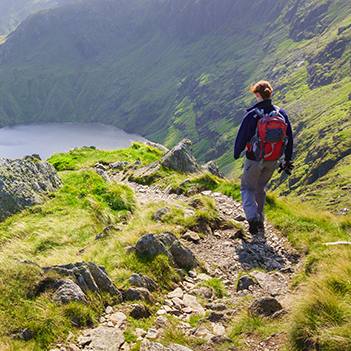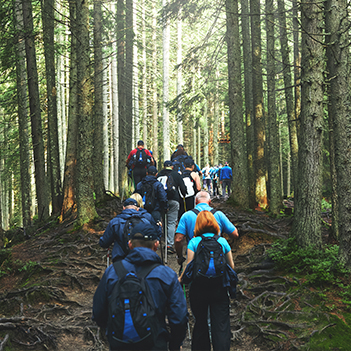Tourist Attractions in the Area of the Valleys 100
We recognise that many entrants are joined for the weekend by their familes. Whilst entrants are walking the Valleys 100, then perhaps their familes might like to visit some of the several tourist attractions in our region. Entrants may themselves wish to visit the attractions either before or after the event. We have supplied a list of places that we think are worth visiting.
Blaenau Gwent
Parc Bryn Bach, just off the A465 Heads of the Valleys road near Tredegar, is set in 340 acres of mixed grass & woodland and has a 36 acre lake as its focal point. Walk or cycle around the lake or picnic or barbeque in the park. There is a visitor centre plus bunkhouse accomodation.
Bedwellty House is a listed Regency villa in Tredegar, surrounded by a historic garden that was established in the early 19th century for the Master of Tredegar Ironworks.
Festival Park shopping village Ebbw Vale is on the site of what was the 1992 Garden Festival of Wales. There are more than 40 shops plus a cafe and 200 seater restaurant with panoramic views across the valley. Family attractions include the UK's longest supertubing run, a large adventure play castle and an owl sanctuary which has over 50 birds of prey.
The Nantyglo Roundhouse complex is a unique relic of the Industrial Revolution. It was built in about 1816 by Joseph & Crawshay Bailey, the Ironmasters of the Nantyglo Ironworks, as a defended refuge against armed revolt by their workforce. In effect, it was the last private castle built in Britain and is now a Grade 2 listed building.
Ty Ebbw Fach Heritage Centre and the Guardian of the Valleys that was completed in 2010, having been commissioned to commemorate the 50th anniversary of the 1960 mining disaster in Six Bells that claimed the lives of 45 men. The 20 metre high sculpture, made from over 20,000 strips of Cor-Ten steel welded together, towers over the site of the former colliery where the tragedy occurred.
Torfaen
Blaenavon World Heritage Site includes a number of top attractions within a short distance.
Big Pit National Mining Museum of Wales was a working coalmine until it closed in 1980. An hour long tour, led by ex-miners, takes you 300 feet down in the pit cage to walk through underground roadways, air doors stables and engine houses to discover how the mine operated and what life was like for the miners and pit ponies.
Pontypool & Blaenavon Railway From Big Pit hop onto a train on the Pontypool & Blaenavon Railway, the highest preserved line in Wales, for the mile or so ride to The Whistle Inn at the end of the line.
Garn Lakes From The Whistle Inn take a stroll around Garn Lakes.
Blaenavon town centre, visit the Ironworks for an insight into the history of industrial Britain. The refurbished workers cottages were used in the award winning BBC docu-drama Coal House in 2007, where three Welsh families relived life in the South Wales coalfields of the 1920's.
Blaenavon Cheddar Company For food buffs a visit to the Blaenavon Cheese Company is a must.
World Heritage Centre After a busy but informative day, call in at the World Heritage Centre where you can find out more about Blaenavon's rich industrial history or just wind down with a cuppa and bite to eat in the cafe.
The Monmouthshire & Brecon Canal is arguably the UK's most scenic. Completed in 1812, it meanders gently for 43 miles from Brecon to Newport. Walk or cycle along its towpath through both rural and urban settings. About a mile from the Valleys 100 start is Pontymoile Marina where you can stop for a cuppa and bite to eat. From there, walk south for a mile or two to the Open Hearth pub in Griffithstown where they have a fine selection of real ales. A few miles further south in Rogerstone, near Newport, is the Fourteen Locks Visitor Centre where you can find out about the history of the Mon & Brec Canal.
The Folly Tower Standing tall and proud above Pontypool and with commanding views of the town, plus Cwmbran and beyond to the Bristol Channel, Folly Tower is passed just after the final checkpoint. It was rebuilt in 1994, having been blown up by the RAF in World War 2 due to its proximity to the Royal Ordnance factory in Glascoed.
Shell Grotto A mile or so further down the hill is the shell grotto, at the top of Pontypool Park. Inside, the walls and ceilings are decorated with thousands of shells of all shapes and sizes, whilst the floor is made from bones. A little known but exceptional gem!
Both are open at weekends and Bank Holidays between May-September between 2-5 p.m.
Greenmeadow Community Farm in Cwmbran offers a great family day out. It is a working farm with animals both large and small, tractor and trailer rides, an adventure playground and a coffee shop.
Llanyravon Manor in Cwmbran dates back to the 17th century. Set in 2.8 acres of land it lay derelict for a number of years before undergoing a #1.6. million restoration which resulted in it being re-opened to the public in 2012. It has a cafe as well as education and training rooms.
Llanyravon Boating Lake Half a mile away is Llanyravon boating lake. Ideal for families, there is a children's playground and a cafe. Stroll around the lake, watch the birds and see what the anglers have caught.
Cwmbran Shopping in the town centre is open 7 days a week, with over 170 shops and 3000 free parking spaces. Most of the centre is undercover and pedestrionised.
Caerphilly CBC
Caerphilly Castle, standing on a 30 acre site near the town centre, is one of the largest fortresses in Europe. When it was designed, Caerphilly Castle was a revolutionary masterpiece in military planning. Anglo Norman in origin, it was built in the 13th century and now boasts a tower which 'out leans' Pisa!
Llancaich Fawr, built in the early 16th century, is one of the finest examples of a semi-fortified manor house in Wales today. Visitors are invited to step back in time and sample the sights, sounds and smells of 1645.
The Winding House Museum in New Tredegar houses a range of attractions and exhibitions, the centrepiece being a magnificent Grade 2 listed winding engine that was used to transport the miners up and down the lift shafts.
Cwmcarn Forest offers something for all the family, (please note that, from May 2012, all car parking is pay & display).
- The 7 mile Scenic Drive takes you through the Forest with car parks at strategic viewpoints, picnic sites and wood carvings.
- Mountain bikers will love the Twrch Trail which has more than 15 km of testing climbs, swooping descents and demanding technical sections.
- There are miles of forest tracks and footpaths to walk.
- A recent addition to the caravan and camping site is a small number of Glamping Pods.
- The new Visitor Centre has a tourist Information Station, gift shop, cafe and toddlers play area.
Parc Penallta, near Ystrad Mynach, is on the site of a former coal tip. It offers spectacular views from the High Point Observatry. Three waymarked trails through woodland, grassland and wetland are punctuated with large sculptures, including Sultan the pit pony, the UK's largest figurative earth sculpture.
The Old Mill, Gelligroes, was built in the 17th century and was once a favoured source of grain milling for local crop farmers. It is now home to the Arthur Moore Amateur Radio Society, a museum where you can learn about Arthur Moore, who received the SOS transmission from the Titanic. Also in the Old Mill is a candle workshop, which has a Royal Warrant to make candles for Prince Charles.
Rhondda Cynon Taff
Rhondda Heritage Park is on the site of the former Lewis Merthyr Colliery at Trehafod, near Pontypridd. The Black Gold Tour is a fully guided tour led by ex-miners, going underground to experience the life of a coal miner as well as visiting the pit head buildings. Youngsters can let off steam in the Energy Zone children's play area. In the visitor centre is a cafe, gift shop and art gallery.
Dare Valley Country Park, Aberdare, covers 500 acres of countryside. It has walks & trails, camping & caravaning, an interactive visitor centre and cafe.
Nantgarw Chinaworks, near Caerphilly, is the only remaining archaeological site of porcelain production in the UK. The grounds contain remains of factory buildings and bottle kilns. The brainchild of William Billingsley, Nantgarw in 1813 was to become the most desirable and sought after porcelain of its time.
Pontypridd Museum is housed in a converted Chapel, built in 1861, and tells the story of the town and its people. Next to the Museum is Edward's Bridge. Built by William Edwards in 1756, for many years it was the longest single span stone bridge in Europe. It took 3 attempts to get the design to stand up. The 140 foot arch, although an attractive shape, was always a bit steep for wheeled traffic.
The Grogg Shop in Pontypridd, established in 1965, is famous for its weird and wonderful creations, in particular the unmistakable sporting 'Uglies' - clay figures of Welsh Rugby Union players.
In the wider area
Caerleon Roman Remains Wales was the furthest outpost of the Roman Empire. In AD 75, the Romans built a fortress at Caerleon that would guard the region for over 200 years. Visit the Museum, the Roman Baths, the ampitheatre, and the legionary barracks.
Cardiff Bay is home to a number of attractions such as Techniquest Science Discovery Centre - ideal for all the family, Craft in the Bay, The Welsh Assembly at the Pierhead, Butetown History and Arts Centre, Goleulong 2000 Lightship, the Norwegian Church Arts Centre and the Wales Millennium Centre, a stunning international arts centre.
Cardiff Castle is one of Wales’ leading heritage attractions and a site of international significance. Located at the heart of the capital, within beautiful parklands, the Castle’s walls and fairytale towers conceal 2,000 years of history.
Cardiff Millennium Stadium is the home of Welsh rugby. Completed in time for the 1999 Rugby World Cup the atmosphere on International match days created by the capacity 74,500 crowd is incredible. The roof can be closed in inclement weather, taking 20 minutes to do so. Rock concerts and other sporting events also take place throughout the year. Take a tour of the stadium and experience the excitement that this iconic stadium creates.
St Fagans National History Museum stands in the grounds of St Fagans castle, a late 16th century manor house. It explores all aspects of how people in Wales have lived, worked and spent their leisure time. During the past 50 years over 40 original buildings from different historical periods have been re-erected in the 100 acre parkland, among them houses, a farm, a school, a chapel and a Workingmen's Institute. There are also workshops where craftsmen demonstrate traditional skills and crafts.
Tredegar House, Newport is one of the architectural wonders of Wales and, as one of the best examples of a 17th century Charles II mansion in the UK, is one of the most significant late 17th-century houses in the whole of the British Isles. Situated within 90 acres of beautiful gardens and parkland, this delightful red brick house provides an ideal setting for a fantastic day out. The house is now managed by the National Trust. There are a number of craft shops in the old outbuildings.
Newport Transporter Bridge opened in 1906 and is one of only 6 operational transporter bridges left worldwide from a total of 20 constructed. Powered by twin 35 hp electric motors the gondola transports cars and passengers across the river Usk which has the highest tidal range of any city in the world.
Chepstow Castle. Chepstow Castle’s construction started in 1067, less than a year after the English were defeated at Hastings. The castle was built due to its strategically important location.




